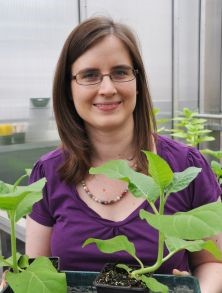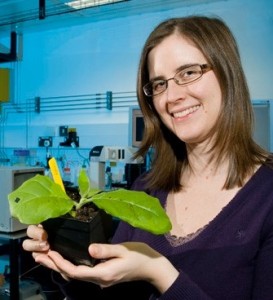Dr. Anne Osterrieder is a Research and Science Communication Fellow at Oxford Brookes University, UK. We asked her expert opinion on the best approaches to raise public awareness of the importance of plants, and what the future holds for science communication.
Anne, you split your time between research and outreach. How do these two aspects of your job influence each other?
The two parts of my role influence each other a lot. My research is fundamental plant biology, trying to understand how plant cells process and transport protein cargo. I know a lot about a very small part of cell biology. Not many people will have heard of the proteins I study, however the Golgi apparatus and cells are part of the school curriculum, which gives me a hook to start a conversation about cell biology. I strongly believe that it is our responsibility to bridge the gap between current plant science and textbooks. What is the purpose of making new discoveries if only a handful of people in the world will ever know about it?
I love it when others get excited about plant cells, and that fuels my own passion for my research. Trying out different ways to communicate science has influenced my writing, my scientific presentations, my teaching, and my thinking.
What sorts of approaches do you think are best for targeting different audiences?
I think, before embarking on any public engagement project, we need to consider two important things: are we going to mainly reach people who are already interested in plant science, or are we reaching out to new audiences? I love the concept of science festivals or Soapbox Science: taking science to public places on a busy day, to attract visitors who normally would not have visited a science event (“I never would have thought that this was so interesting!”).
I also believe it is important to design projects that allow interaction and dialogue. It is very tempting to see ourselves as the experts, spurting out knowledge like a garden hose. However, I realize that my ‘vast expertise’ is very limited to a narrow niche topic. Everyone has a different background and experiences. When we allow our different perspectives to collide, exciting and unexpected things might happen.
#soapboxscience has its fifth birthday this year – thanks to all our speakers and volunteers for 5 years of pure fun pic.twitter.com/l5dGdHXRp7
— SoapBox Science (@SoapboxScience) May 8, 2015
How can we dispel the “plants are boring” stereotype and attract more young people to enter plant science?
I spend a lot of time thinking about this question. One of the main problems is ‘plant blindness’, and the fact that plants are just there and don’t seem to be doing much. We try to dispel this myth by showing how much is going on inside plant cells. Rather than solely dispensing facts about plants, we should discuss the questions that make us curious, and inspire us to study plants. When I look at a flower, I wonder how it knows how to make petals. How does a seed know how and when to grow into a big plant? Are Golgi bodies the same size in Sequoia trees as they are in a daisy? If not, how do they know how to change their size – and if yes, how do they know how to not change their size?
By putting questions in the foreground, we can communicate what we know, and then explore together what we don’t know. But most importantly, if we want to inspire, we have to include our emotions alongside our facts. Passion and enthusiasm can make even the most boring topic exciting and gripping.
Do you have any thoughts on how the plant science community could better connect with agricultural stakeholders and policy makers?
When I went to a conference last year, I learnt about ‘EIP-AGRI’, the agricultural European Innovation Partnership, a network that aims to connect researchers, farmers, agribusinesses and other stakeholders. I think that networks like this, as well as learned societies, are important hubs for connecting scientists with other stakeholders.
Do you think science communication is something all scientists should be doing, or are dedicated specialists like yourself more effective at getting the message across, especially when it comes to heavily debated topics such as GM, genome editing or synthetic biology?
I think there is a need for both. I feel that all academic researchers should become involved in public engagement, but dedicated specialists might have more experience to tackle more difficult questions and can provide advice and training for more casual communicators. Before I became more involved with science communication, I had not realized at all that it was a discipline on its own. I think there should be much more interaction between scientists and science communicators (both professionals and researchers) to exchange information about ‘best practice’ and lessons learned.
How do you envisage the future of plant science communication?
I hope researchers embrace creativity and step out of their comfort zone to try out new ways of communication, and engage new audiences. I also hope that plant science communication will happen offline and online, and that people will maximize their impact by interlinking both!
You can find out more about Dr. Osterrieder’s public engagement projects by visiting her website, Plant Cell Biology, or by following her on Twitter @AnneOsterrieder. Hear more of Anne’s advice for plant science communication in this 11 minute video lecture:
https://youtube.com/watch?v=XKUfpiFfhgQ%3Frel%3D0







